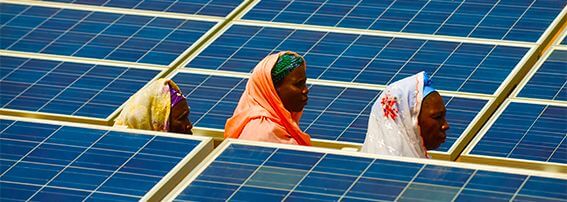In a wake up call to national and international decision makers, the Overseas Development Institute (ODI) examined the projected progress of the Sustainable Development Goals (SDGs), and found that a 'revolution' is needed to achieve SDG7—clean, affordable, modern energy for all—by 2030. Grading the progress towards SDG7 a ‘D’ (two above a reversal in progress), ODI researchers calculated that the rate of change must be between 3-4 times faster to meet the universal energy access target. A business-as-usual approach will leave a billion people without power in 2030, with the total absolute number of people without electricity in Africa increasing, rather than decreasing.
In the run up to the first anniversary of the SDGs we must therefore ask the question, how can we change the path of energy access?
Decentralized Renewables: From Policy to Power
Decentralized renewable energy (DRE) will be at the heart of the energy access revolution. Already powering 100 million people worldwide, rooftop solar and renewable energy mini-grids, are rapidly responding to the energy access challenge. That has in large part been because of pioneering governments who have integrated DRE into national energy plans and policies. Understanding the impact of these policies on market growth and energy access is key to enabling other countries to join a global shift towards a new energy pathway that can meet SDG7. While several institutions have looked at the DRE energy sector to explore vital market levers, Power for All has undertaken new quantitative and qualitative research to determine which key policy factors correlate to market growth.
Early Findings: Key factors driving DRE markets and energy access
Through a study of the top five South Asian and Sub-Saharan markets for mini-grids, rooftop solar and other lighting solutions*, the initial findings of our research team—based at the University of California, Berkeley—show that five key indicators have the greatest correlation to the sales of decentralized renewable technologies and sector presence:
- Low policy barriers (e.g. the elimination or reduction of import duties)
- Microfinance Institutions (MFIs) lending to clean energy
- DRE regulatory framework
- Enabling framework
- Energy access policies
Ranked in order, the first three of these indicators—low policy barriers, MFIs lending to clean energy and DRE regulatory framework—show the strongest relationship to vibrant DRE markets.
The research—a draft of which will be presented in September at the LeNSes conference in Cape Town by our campaign director Kristina Skierka, with a paper released in full in October—is designed to help national governments, and other key actors, get more clarity on the most effective drivers of energy access and help them to prioritize efforts to accelerate DRE markets. The paper will also highlight the importance of engaging the energy poor in building energy access solutions, and explore models for the adoption of new technologies that will lead to a sustained market transformation.
Watch this space for more details of the bold steps needed to drive the shift to a new energy pathway—and to clean, affordable, modern energy for all.
---
Join the Power for All campaign to be the first to get the new paper out next month.
Already a Partner? Watch out for upcoming opportunities to help shape and drive our next Call to Action.
*Note on methodology: The Power for All findings are based on a regression analysis of data compiled by Climatescope—a project of Bloomberg New Energy Finance—for the top five decentralized solar and mini-grid markets in the world: Bangladesh, Ethiopia, India, Kenya and Tanzania. These countries account for 97 percent of decentralized solar adoption in developing Asia (India and Bangladesh), and 67 percent of adoption in Sub-Saharan Africa (Kenya, Tanzania and Ethiopia)
